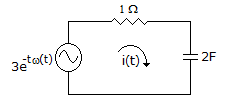Electronics and Communication Engineering - Networks Analysis and Synthesis - Discussion
Discussion Forum : Networks Analysis and Synthesis - Section 1 (Q.No. 42)
42.
In the circuit shown in given figure, the values of i(0+) and I(∞), will be respectively


Answer: Option
Explanation:

I(t) = 6 e-t - 3 e-0.5t
at t = 0, I(0) = 3A
at t = ∞, I(∞) = 0.
Discussion:
3 comments Page 1 of 1.
Himanshu Patel said:
1 decade ago
Make it more simpler.
For i(t) when t = 0,
Put t = 0 in Ohms law equation.
V = 3 (Because e^0 = 1).
V = IxR.
I = V/R = 3/1.
So, I = 3A.
Similarly for i(infinity) put t = infinity.
V = 0(e^-infinity = 0).
V = IxR.
I = 0A.
For i(t) when t = 0,
Put t = 0 in Ohms law equation.
V = 3 (Because e^0 = 1).
V = IxR.
I = V/R = 3/1.
So, I = 3A.
Similarly for i(infinity) put t = infinity.
V = 0(e^-infinity = 0).
V = IxR.
I = 0A.
(1)
Parashu kn said:
8 years ago
I(0+) is capacitor is short circuit
I(0+)=3/1
=3A.
I(∞) is capacitor is open circuit there is no curent flow.
I(∞)=0A.
I(0+)=3/1
=3A.
I(∞) is capacitor is open circuit there is no curent flow.
I(∞)=0A.
Muhammad Mutzalzalzaman said:
7 years ago
At t=0+ capacitor short circuit with reactance=0 so current =3A.
At t=infinity capacitor opens and maximum reactance in current path so current=0.
At t=infinity capacitor opens and maximum reactance in current path so current=0.
Post your comments here:
Quick links
Quantitative Aptitude
Verbal (English)
Reasoning
Programming
Interview
Placement Papers